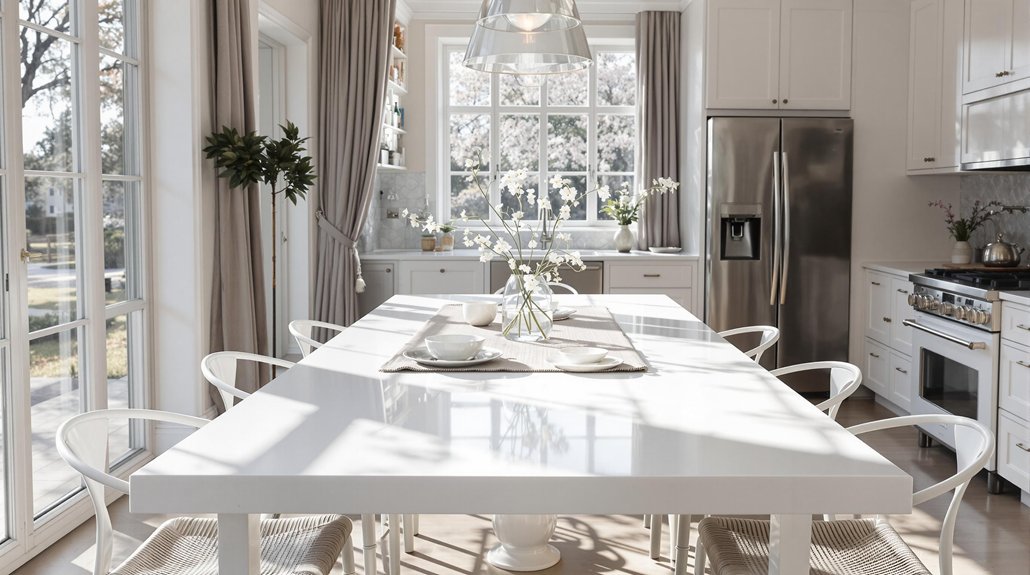
16 White Kitchen Table Ideas That Are Light and Inviting
A white kitchen table instantly brightens dining spaces, offering visual spaciousness and timeless appeal. Pairing white with natural wood accents introduces warmth, while textural elements such as upholstered chairs or layered runners create depth and tactile interest. Bold centerpieces and blue accents evoke a modern coastal vibe, and fresh greenery infuses vibrancy. Patterned rugs, monochrome accessories, and strategic lighting further refine and personalize the setting. For inspiration on expertly blending these elements, discover additional refined design approaches ahead.
Key Takeaways
- Pair a white kitchen table with natural wood chairs or accents for warmth and balanced contrast.
- Add a bold centerpiece or fresh greenery to introduce color and visual interest to the table.
- Use soft pastel linens and decorative accessories to create a luminous, tranquil atmosphere.
- Select a round white table with minimalist chairs to maximize space and maintain an airy feel in small kitchens.
- Incorporate geometric or floral patterned rugs beneath the table for added depth and personality.
Embrace an All-White Dining Table and Chairs
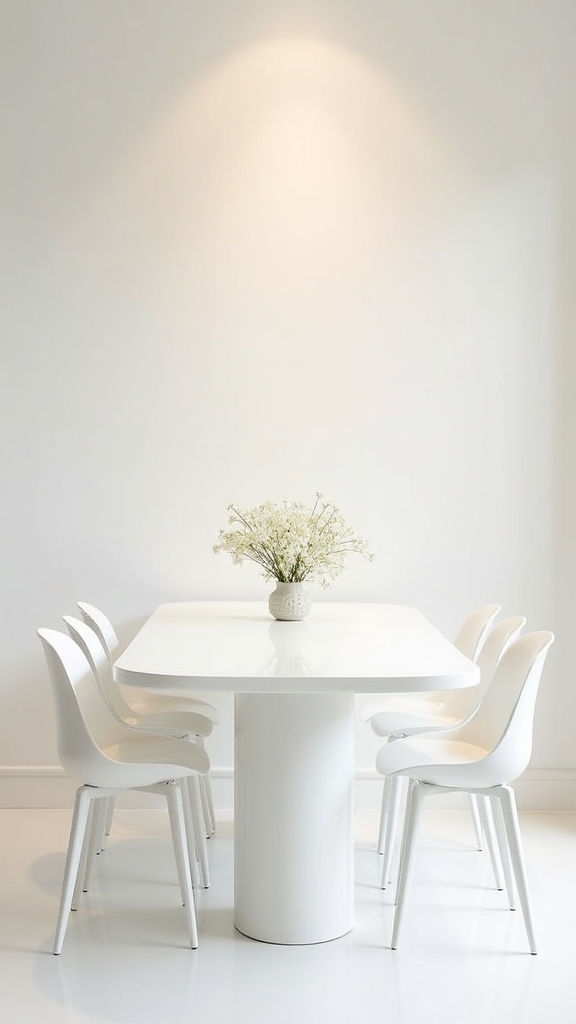
When incorporated into a dining area, an all-white table and chairs establish a crisp, refined aesthetic that seamlessly adapts to a range of design styles, from contemporary minimalism to rustic charm.
Selecting a white dining table as the centerpiece enhances the perception of space and amplifies natural light, making it exceptionally suitable for compact dining rooms. This palette fosters a sense of openness and tranquility, providing a versatile foundation for evolving dining room ideas throughout the seasons.
To avoid sterility, adding subtle texture through fabric upholstery or matte finishes contributes warmth and tactile interest.
Maintenance is straightforward—regular cleaning with a damp cloth and the use of placemats preserve the pristine quality.
An all-white dining set serves as a timeless, highly adaptable solution for any interior scheme.
Pair Your White Table With Natural Wood Accents
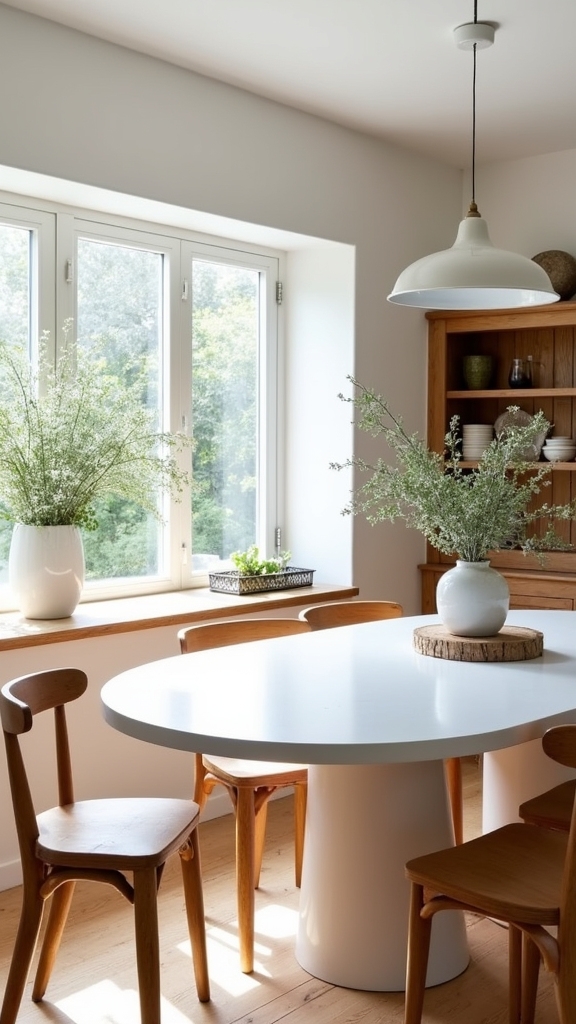
Introducing natural wood accents alongside a white kitchen table achieves a balanced interplay of warmth and crispness within the dining space.
The juxtaposition of wood grain and white surfaces not only highlights organic textures but also enhances visual interest.
Thoughtful integration of these elements creates a harmonious setting that feels both inviting and contemporary.
Balance White With Warmth
By pairing a white kitchen table with natural wood accents, a kitchen dining area achieves both visual warmth and balanced contrast. In a white dining room, the introduction of natural wood—whether through light oak chairs, a rustic sideboard, or a butcher block centerpiece—brings tactile richness and softens the overall look. The interplay between crisp white surfaces and textured wood guarantees the space feels inviting, rather than sterile. Light wood finishes, such as maple or birch, maintain an airy palette while grounding the design. This combination not only enhances visual depth but also infuses the room with a sense of organic tranquility.
| Element | Design Benefit |
|---|---|
| Light Wood Chairs | Adds warmth, softens contrast |
| White Table | Provides crisp, clean anchor |
| Wood Centerpiece | Introduces tactile interest |
| Sideboard (Natural Wood) | Grounds space, adds depth |
Mix Wood and Whites
Although a white kitchen table establishes a crisp, clean foundation for the dining area, integrating natural wood accents enhances the design with nuanced warmth and texture.
This pairing of a white dining room table with oak dining elements introduces visual contrast while fostering a welcoming ambiance. The juxtaposition of white and wood easily bridges modern minimalism and rustic character, allowing the space to feel both curated and inviting.
Designers often recommend mixing wood finishes—such as light oak with pristine white—for a dynamic, layered aesthetic that avoids monotony. Thoughtfully selected wooden accessories further unify the look.
Consider these methods for mixing wood and whites:
- Pair solid oak or reclaimed wood chairs with a white table
- Incorporate wooden serving trays and centerpieces
- Use a light oak dining bench for functional style
- Blend differing wood grains for depth
Highlight Natural Grain
A thoughtful interplay of white surfaces and natural wood accents enhances the visual interest of a kitchen dining area, infusing it with both warmth and organic texture.
Pairing white furniture, such as a crisp white table, with natural wood elements—like wooden chairs or a rustic sideboard—creates a dynamic contrast that feels both inviting and grounded.
Integrating a live-edge wood bench alongside white furniture introduces a tactile focal point, evoking a relaxed yet sophisticated atmosphere.
The juxtaposition of clean white lines and the inherent variation of natural wood grain suits diverse design aesthetics, from Scandinavian minimalism to modern farmhouse charm.
Finishing touches, such as wooden serving trays or bowls, unify the space, ensuring a cohesive visual narrative that celebrates natural materials and timeless style.
Add Texture With Cozy Cushions and Table Runners
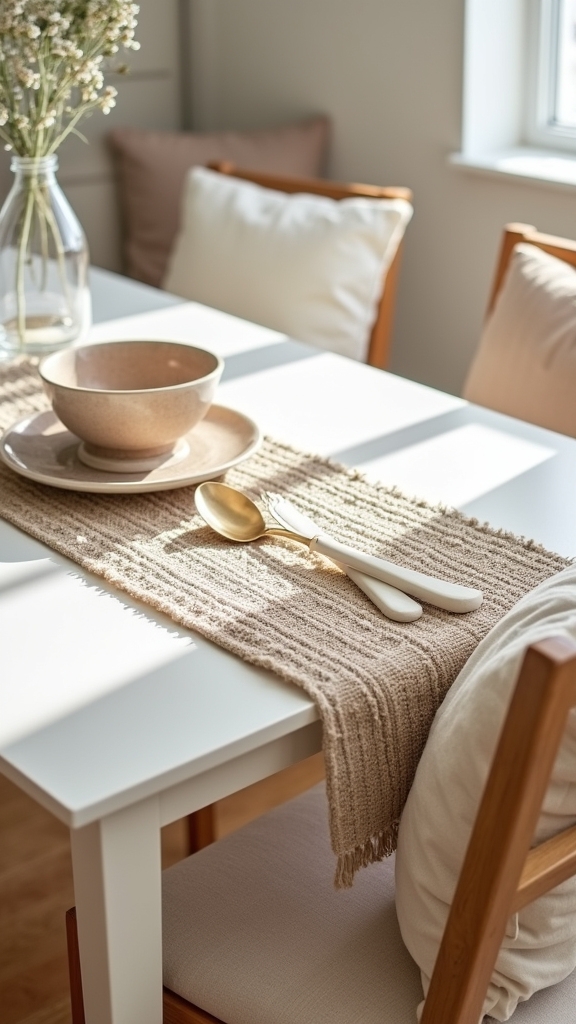
Layering patterns and fabrics with cushions and table runners introduces dimension and tactile appeal to a white kitchen table.
Designers often recommend mixing materials—such as soft textiles with woven accents—to achieve warmth and visual contrast.
Strategic selection of these accessories allows the table to become a dynamic focal point while maintaining a cohesive atmosphere.
Layering Patterns and Fabrics
Visual depth emerges when patterns and fabrics are thoughtfully combined atop a white kitchen table, transforming a minimalist surface into a dynamic focal point. Layering patterns with textured fabrics, such as linen or cotton, enhances tactile appeal and introduces subtle dimension.
Table runners in muted hues provide a sophisticated foundation, while cushions featuring varied prints inject character and seasonal versatility. Strategic selection of fabric and color guarantees the setting remains light and airy, avoiding visual clutter while amplifying warmth and coziness.
The interplay of these elements raises the everyday dining experience by encouraging personalization and inviting comfort.
- Linen or cotton table runners for tactile interest
- Cushions with playful patterns or prints
- Neutral or pastel shades to maintain brightness
- Mixing quilted runners and patterned cushions for depth
Mixing Materials for Warmth
Several carefully chosen materials can infuse a white kitchen table with warmth and tactile richness, elevating both style and comfort.
Mixing materials—such as pairing a sleek white dining room table with wooden or metal accents—introduces visual balance and grounds the overall design.
Cozy seat cushions in soft fabrics add both ergonomic support and a contrasting tactile layer, while decorative patterns or complementary colors on the cushions contribute personality and depth.
Table runners crafted from linen, cotton, or woven knits further soften the starkness of a white surface, providing an inviting, layered effect.
The thoughtful combination of materials and textures transforms the dining area, making it more welcoming and visually engaging.
This nuanced approach to mixing materials guarantees the white dining room table remains both sophisticated and approachable.
Highlight the Table With a Bold Centerpiece
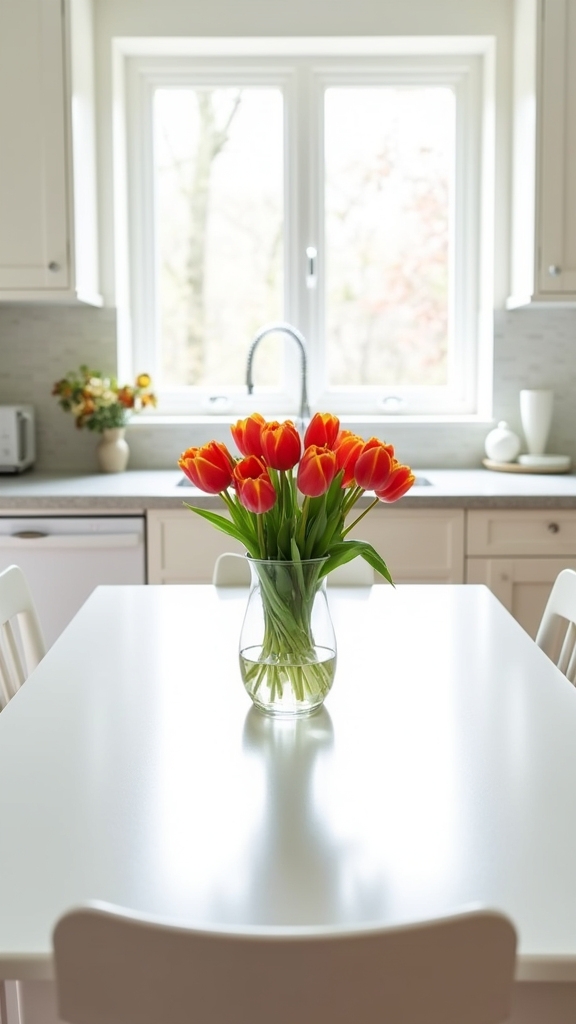
A single, bold centerpiece instantly enhances a white kitchen table by creating a visual focal point that commands attention. The interplay of a striking centerpiece with the table’s clean, light backdrop uplifts the dining area, infusing it with character and style.
Strategic use of contrasting colors and sculptural forms not only draws the eye but also reinforces the inviting atmosphere of the space. Designers often recommend incorporating seasonally relevant objects and layered textures to maintain freshness and dimension.
Consider these bold centerpiece options for a white kitchen table:
- A vibrant floral arrangement in deep reds or bright yellows
- An oversized, sculptural vase or unique candle holder
- Seasonal décor, such as pumpkins or seashells
- A woven or textured runner beneath a striking fruit bowl
Incorporate a Modern Coastal Vibe With Blue Accents
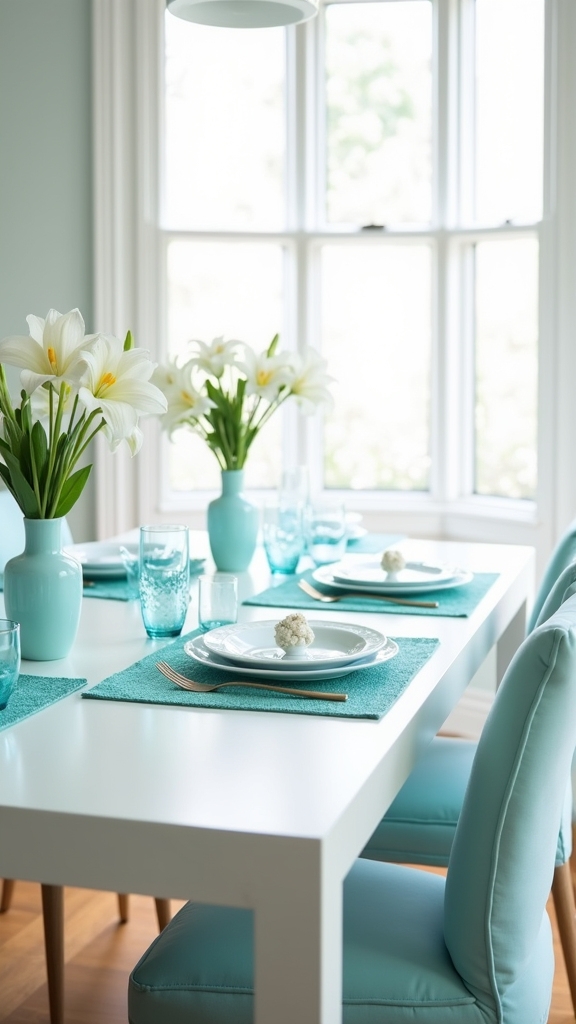
How might a white kitchen table transform into a modern coastal statement with the strategic use of blue accents? Designers often recommend integrating blue and white tile flooring in the dining area to establish a seamless coastal foundation.
By pairing the crisp white table with navy barstools or blue placemats, the palette gains dimension and sophistication while preserving a light, airy ambiance.
Thoughtful decorating ideas, such as incorporating sea-inspired centerpieces or blue glassware, introduce personality and visual interest without overpowering the minimalist aesthetic.
This approach leverages a harmonious blend of cool tones and subtle textures, resulting in a serene, inviting environment.
Ultimately, blue accents enhance the modern coastal vibe, elevating the white kitchen table’s role as a focal point within a rejuvenating, beach-inspired dining space.
Choose a Glossy White Table for a Sleek Look
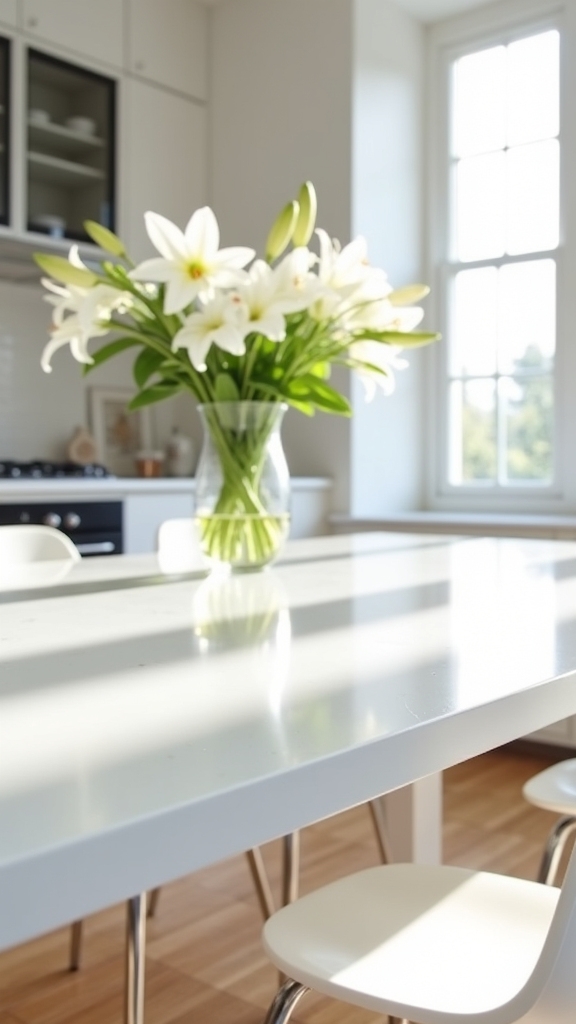
While blue accents infuse a modern coastal sensibility, selecting a glossy white table introduces a distinctly sleek and contemporary aesthetic to the kitchen or dining area.
The reflective quality of a glossy white dining room table enhances ambient light, visually expanding the space—an ideal solution for compact dining rooms. This finish not only delivers a luminous, polished effect but also proves highly functional, resisting stains and scratches for seamless daily maintenance.
The versatility of a glossy white table supports a range of design styles, from minimalism to urban chic, and serves as a sophisticated focal point in any setting.
- Amplifies natural light and visually enlarges the dining area
- Provides a stain- and scratch-resistant surface for practical usage
- Pairs effectively with dark chairs for visual contrast
- Integrates seamlessly with contemporary and transitional interiors
Mix White Furniture With Soft Pastels
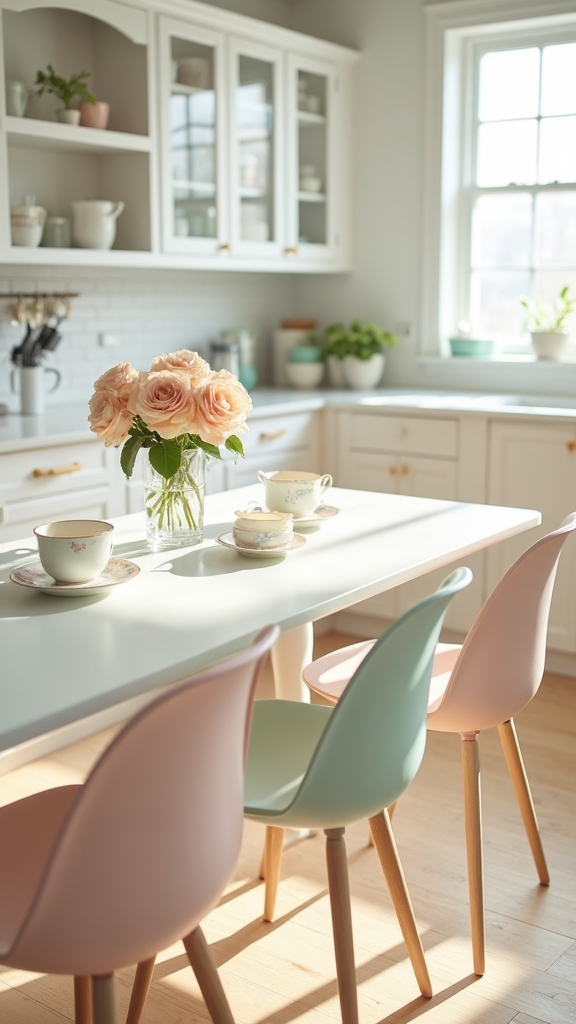
Many interiors benefit from the harmonious interplay of white furniture and soft pastels, resulting in a kitchen or dining area that feels luminous and tranquil.
The integration of soft pastels—such as mint green, blush pink, and pale blue—alongside white tables and chairs establishes a serene yet inviting atmosphere.
These gentle hues introduce subtle warmth and personality, enhancing the inherent brightness of white furniture without overpowering the space.
Thoughtful incorporation of pastel accents, including table linens, dishware, and decorative pieces, creates visual cohesion and depth.
Pastel tones in wall art or curated decor elements further reinforce the calming environment, making the room ideal for gatherings and everyday meals.
This balanced palette delivers a refined aesthetic, promoting both relaxation and sophisticated visual interest.
Create Contrast With Black Dining Chairs
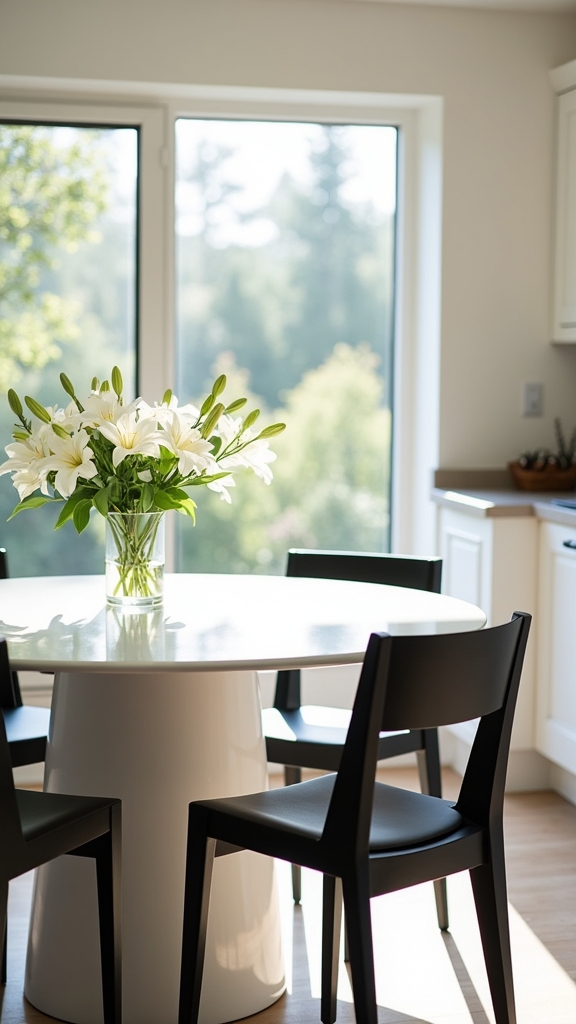
Pairing a crisp white kitchen table with black dining chairs creates a bold monochrome dining statement, instantly enhancing the room’s visual impact.
This interplay of light and dark introduces a sense of balance, preventing the space from feeling either too stark or too heavy.
The high-contrast combination also imparts a modern edge, aligning seamlessly with contemporary interior trends.
Bold Monochrome Dining Statement
A kitchen’s visual impact can be dramatically enhanced by juxtaposing a crisp white table with bold black dining chairs, establishing a refined monochrome statement. This black and white pairing delivers striking contrast, instantly modernizing the space and drawing the eye to the dining area as a central feature.
The clean silhouette of a white kitchen table is accentuated by the strong presence of black dining chairs, emphasizing both simplicity and sophistication. By integrating a variety of materials—such as matte metal or sleek leather for the chairs—designers introduce visual depth without detracting from the overall harmony.
Additionally, the monochrome palette creates a timeless canvas for personal expression.
- Contrasting black dining chairs heighten visual drama
- Monochrome palette supports versatile accessorizing
- Textural combinations add dimensional interest
- Durable black chairs enhance practicality
Balancing Light and Dark
Striking contrast emerges when a white kitchen table is set alongside black dining chairs, producing a visually engaging interplay between light and dark elements.
This pairing enhances the aesthetic of dining tables and chairs, drawing attention to the white painted surface as a focal point within the room. The juxtaposition not only defines the dining area but also introduces depth and visual interest, making the space feel both dynamic and balanced.
The crisp lines of the white painted table are accentuated by the bold presence of black chairs, allowing for the integration of varied textures and materials without overwhelming the decor.
This approach delivers timeless appeal, ensuring compatibility with both contemporary and traditional interiors, while emphasizing the sophistication of a thoughtfully curated dining space.
Modern Edge Through Contrast
Contrast emerges as a defining element when a white kitchen table is set against black dining chairs, instantly infusing the dining area with a modern, visually arresting edge.
The interplay of white paint and dark-toned Dining Room Furniture not only enhances the aesthetic but also introduces a sophisticated depth to the space. This juxtaposition serves as a compelling focal point, drawing the eye and underscoring the crisp lines of contemporary design.
The strategic use of finishes—whether matte or glossy—on the black chairs further enhances texture and visual intrigue, ensuring a space that feels both dynamic and inviting.
- Striking visual contrast amplifies modern appeal
- Depth and dimension introduced through light-dark interplay
- Black chairs as a bold visual anchor to the white table
- Versatile design suits minimalist or eclectic aesthetics
Opt for a Farmhouse-Style White Table
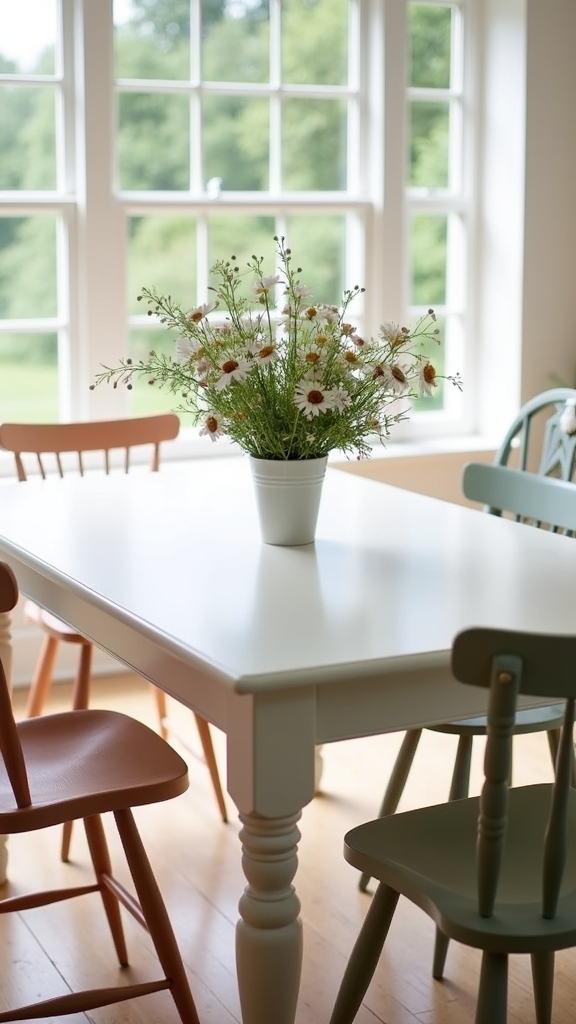
Many kitchens benefit from the enduring appeal of a farmhouse-style white table, which anchors the space with rustic character and practical elegance.
Showcasing distressed finishes and solid wood construction, these tables evoke a sense of heritage while offering exceptional durability. The farmhouse-style white table seamlessly integrates into both traditional and modern interiors, thanks to its classic silhouette and versatile design.
Extension capabilities enhance its functionality, readily accommodating family gatherings or larger groups. Simple, clean lines characterize the aesthetic, allowing for effortless coordination with a variety of seating arrangements and accessories.
Use Minimalist Decor for an Airy Feel
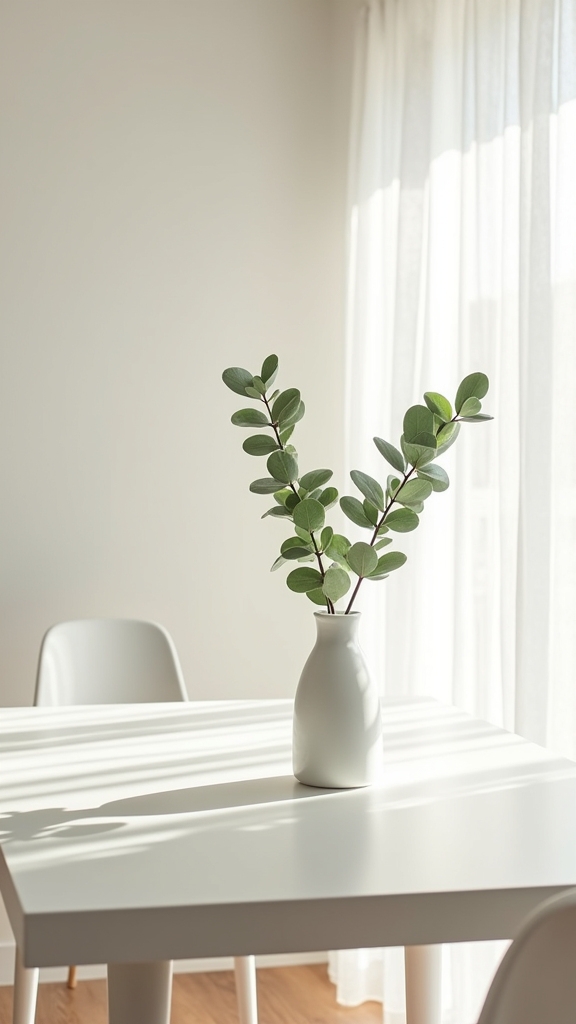
Minimalist decor, rooted in the principles of simplicity and functionality, allows a white kitchen table to emerge as the visual centerpiece of the space.
By thoughtfully limiting decorative elements, the environment achieves an airy feel that emphasizes spaciousness and light. The strategic use of transparent materials, such as glass or acrylic seating, enhances this openness without detracting from the table’s crisp aesthetic.
Essential accessories—like soft linen runners or neatly folded cotton napkins—contribute subtle warmth, maintaining visual restraint. Incorporating carefully selected botanical accents introduces vibrancy while upholding the minimalist decor ethos.
To achieve an airy and inviting atmosphere, consider these approaches:
- Select transparent chairs to amplify openness
- Use soft textiles for understated texture
- Display minimal, well-chosen table accessories
- Add a single potted plant or fresh flowers
Enhance Light With Mirrors and Chrome Details
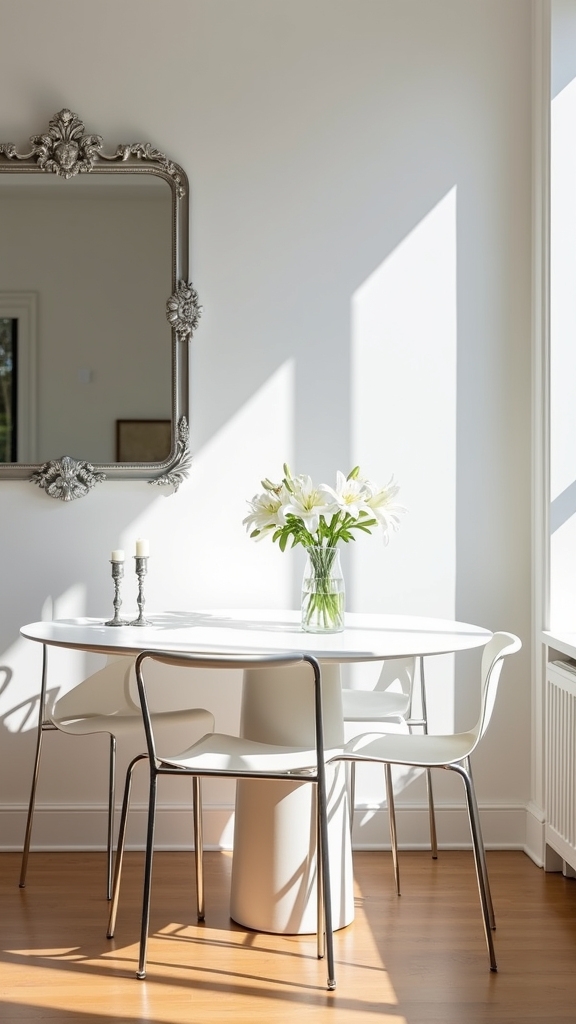
By integrating mirrors and chrome details into the dining area, a white kitchen table setting can be transformed into a luminous, visually dynamic space.
Mirrors, when positioned to reflect natural light from windows, expand the sense of space and amplify brightness, complementing the crisp aesthetic of a white table.
Chrome details—seen in chair legs, table edges, or accent lighting—offer reflective surfaces that further distribute light, reinforcing the room’s modern and airy character.
Together, these elements create a harmonious interplay of light and reflection, enhancing the sense of cleanliness and openness.
A carefully curated balance of mirrors and chrome details not only boosts the visual appeal but also reinforces the inviting atmosphere essential for welcoming gatherings around a white kitchen table.
Layer Lighting for an Inviting Ambience
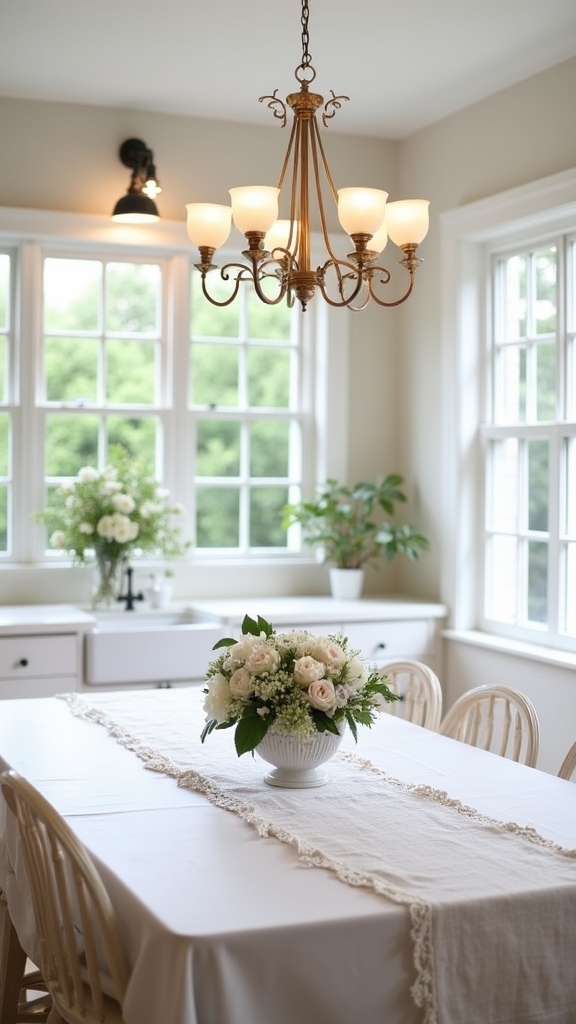
While the crisp elegance of a white kitchen table sets a bright foundation, the strategic layering of lighting is essential to cultivate a truly inviting ambience.
Layered lighting—incorporating ambient, task, and accent sources—elevates both the functionality and aesthetic of the space. Dimmable LED fixtures offer flexible control, allowing the environment to shift seamlessly from energetic meal preparation to relaxed dining.
Pendant lights above the table establish a visual focal point, accentuating the minimalist lines and luminous finish of the white surface. Natural light, maximized through unobstructed windows, amplifies the airiness and openness of the dining area.
Accent lighting, such as under-cabinet illumination or decorative sconces, further enhances evening gatherings.
Weather-resistant fixtures ensure that the lighting remains functional and stylish even in outdoor settings.
Key strategies include:
- Ambient overhead lighting
- Dimmable LED fixtures
- Pendant lighting focal points
- Accent lighting for depth
Bring in Fresh Greenery and Floral Arrangements
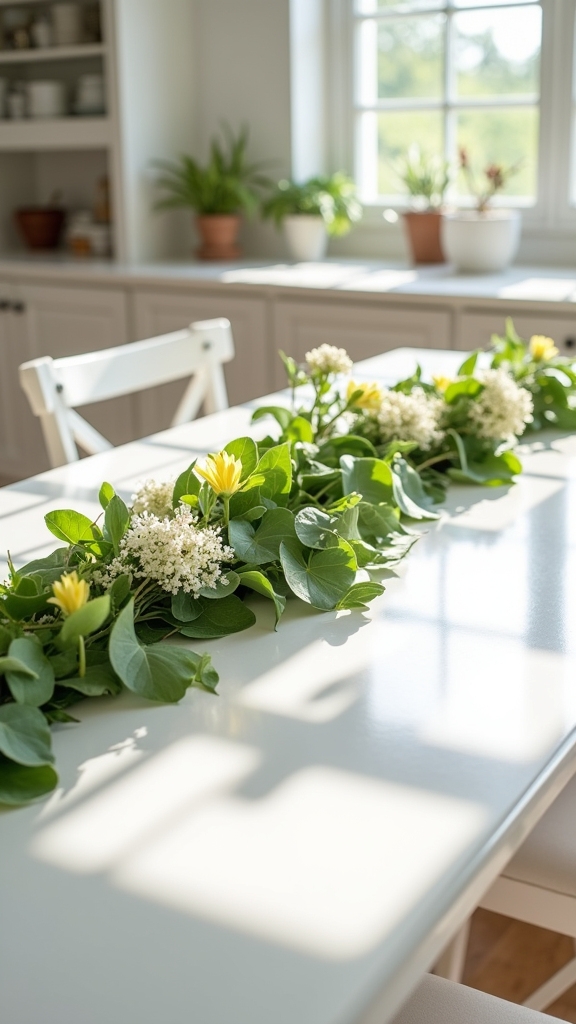
After establishing an inviting ambience through thoughtful lighting, incorporating fresh greenery and floral arrangements introduces organic texture and vibrant color to the refined backdrop of a white kitchen table.
Fresh greenery, such as potted herbs or low-maintenance succulents, enhances the lightness of the space while subtly infusing a touch of nature.
Floral arrangements in soft pastel hues complement the table’s crisp aesthetic and serve as a visually striking focal point without overpowering the setting.
Utilizing clear glass vases maintains the room’s airy quality, allowing the natural beauty of the arrangement to shine.
Layering greenery and blossoms at varying heights lends depth and dimension, creating visual interest.
Seasonal blooms further enliven the atmosphere, ensuring the dining area feels dynamic, welcoming, and thoughtfully curated throughout the year.
Select a Round White Table for Small Spaces

A round white table serves as an efficient centerpiece for compact dining areas, optimizing spatial flow and reducing hard visual lines.
Its curved silhouette enhances movement within the room and fosters a sense of openness.
Pairing this table with minimalist chairs further amplifies its airy aesthetic while maintaining a streamlined, functional environment.
Maximizing Compact Dining Areas
In compact dining areas, selecting a round white table offers both spatial efficiency and visual lightness, essential for maximizing limited square footage.
The curved silhouette of round white tables naturally facilitates movement, allowing for easier navigation in tight quarters. Their absence of corners creates a more flexible seating arrangement, accommodating extra guests without crowding.
The light-reflective white finish amplifies brightness, contributing to an airy, open ambiance ideal for small environments. Design professionals recommend this solution for its blend of function and visual simplicity.
Consider the following advantages:
- Smooth, rounded edges prevent congestion and support fluid circulation.
- White surfaces visually expand the room, reflecting natural and artificial light.
- Extendable round tables provide adaptable seating for varying occasions.
- Pedestal bases increase available legroom, minimizing spatial obstructions.
Enhancing Flow With Curves
Building on strategies for maximizing compact dining areas, the introduction of curves through a round white table offers a sophisticated solution for enhancing spatial flow.
In Room Design, the absence of sharp corners facilitates seamless movement, making circulation significantly more efficient in limited dining spaces. This circular form not only encourages closer, more intimate interactions but also visually softens the dining environment, counteracting any rigid architectural lines.
The white finish amplifies natural light, fostering an illusion of openness and airiness that expands the perceived size of the room. Additionally, many round tables feature extending mechanisms, granting versatility for hosting guests without permanently occupying excess space.
The combined effect of form and color transforms small dining zones into welcoming, visually harmonious settings that prioritize both function and aesthetic appeal.
Pairing With Minimalist Chairs
When optimizing a compact dining space, selecting a round white table paired with minimalist chairs introduces both spatial efficiency and visual harmony.
The round silhouette of a white table maximizes usable area and encourages fluid movement, while minimalist chairs—defined by their clean lines and understated profiles—reinforce an open, uncluttered aesthetic.
This combination not only guarantees a light, inviting atmosphere but also fosters intimacy and ease of interaction among diners.
The versatility of white allows seamless integration with a range of chair materials and finishes, from matte metal to pale wood, enabling a tailored yet cohesive look.
Opting for a pedestal base further enhances legroom and eliminates visual bulk.
- Round white table optimizes seating in small spaces
- Minimalist chairs amplify the airy ambiance
- Pedestal base increases comfort and accessibility
- White palette unites diverse chair materials
Style With Monochrome Accessories
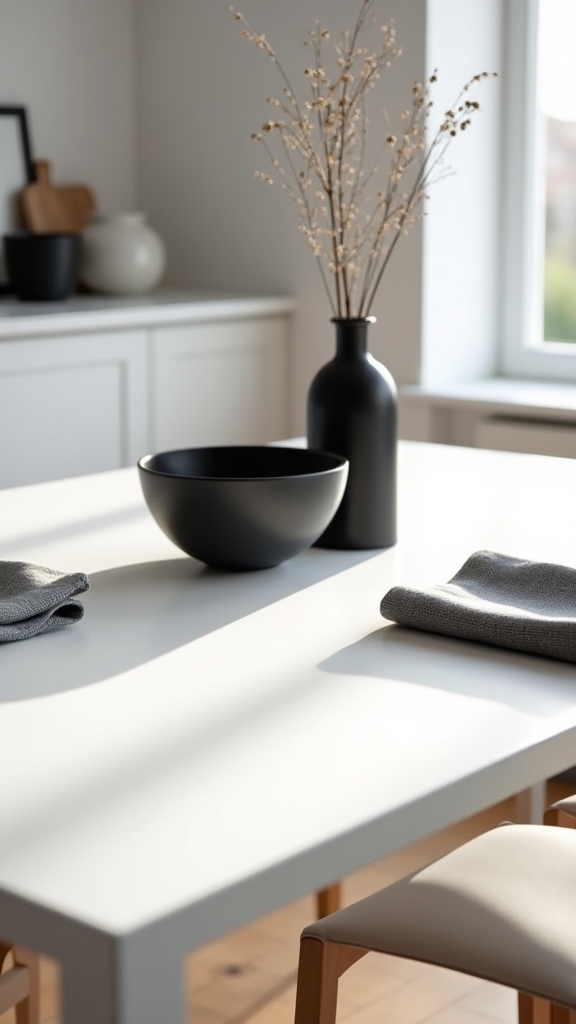
Enhance the aesthetic of a white kitchen table by introducing monochrome accessories that deliver dramatic contrast and refined visual structure. Monochrome accessories—such as matte black ceramics, glossy white porcelain, or black and white tableware—inject visual interest without overwhelming the room. This palette allows the white table to anchor the space, while layered shades and textures create depth and sophistication. Against white walls, a curated selection of monochrome artwork or decorative pieces, like vases and candlesticks, establishes a harmonious flow. Patterned table linens in black and white serve as elegant backdrops, maintaining a cohesive design language. To further enhance the overall design, consider incorporating black accessories that align with the monochrome theme for a cohesive and polished look. The following table highlights effective monochrome accessory pairings:
| Accessory Type | Finish/Texture | Visual Impact |
|---|---|---|
| Tableware | Matte/Glossy | Striking Contrast |
| Linens | Patterned | Subtle Structure |
| Decorative Items | Ceramic/Metallic | Modern Sophistication |
Combine White Furniture With Patterned Rugs
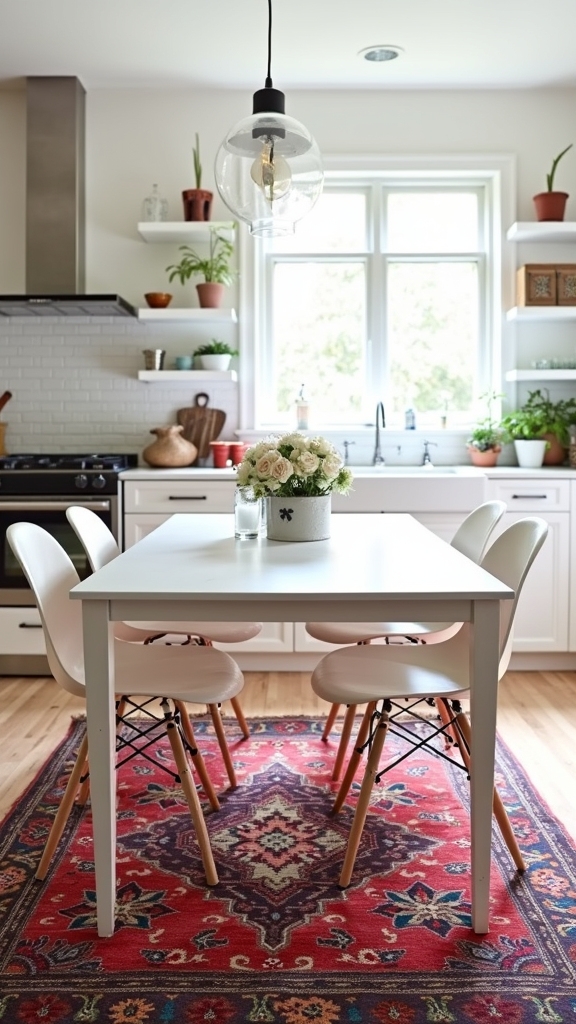
While monochrome accessories cultivate a sense of balance and sophistication around a white kitchen table, the introduction of a patterned rug offers a dynamic layer of texture and color beneath the furniture.
Patterned rugs can create vibrant contrast, anchoring white furniture while infusing the dining area with depth and personality. Geometric or floral motifs add visual intrigue, complementing the minimalist aesthetic of white surfaces.
For cohesion, designers recommend selecting rug hues that echo existing kitchen elements, such as backsplash tiles or accent decor.
Practicality is essential in kitchen settings; durable, easy-to-clean materials like polypropylene guarantee longevity and maintain appearance despite spills or frequent use.
- Pair white furniture with geometric or floral patterned rugs
- Choose rug colors that coordinate with kitchen accents
- Select easy-care materials suitable for high-traffic zones
- Layer rugs over neutral floors for added visual warmth
Frequently Asked Questions
What Can I Have Instead of a Dining Table?
When considering alternative dining options, one might explore kitchen table substitutes such as multifunctional kitchen islands, rustic benches, drop-leaf tables, bar carts, or a curated lounge nook with cushions and a low table for versatile, visually engaging dining experiences.
What Do You Put in the Middle of a Kitchen Table?
When considering what to place in the middle of a kitchen table, table centerpieces such as minimalist vases, decorative trays, or seasonal decorations offer visual interest, enhance spatial balance, and serve as focal points within a thoughtfully curated dining environment.
What Color Should a Kitchen Table Be?
Selecting a kitchen table color involves considering table color psychology and current kitchen decor trends. Neutral hues foster versatility and tranquility, while bold choices introduce focal points. Harmonizing the table with surrounding elements enhances spatial cohesion and visual impact.
How Can I Make My Table Look Fancy?
To achieve a sophisticated look, one should focus on table decor by selecting elegant settings with refined linens, curated centerpieces, and layered textures. Utilizing coordinated dinnerware, glassware, and decorative accents enhances visual interest, creating a polished, enhanced atmosphere.
Conclusion
A white kitchen table serves as a versatile foundation, effortlessly enhancing both modern and classic interiors. By integrating natural wood, textural accents, and bold centerpieces, homeowners can create a visually inviting and dynamic dining space. Strategic styling—from monochrome accessories to patterned rugs—elevates the table’s appeal, while greenery and coastal hues inject freshness. Ultimately, these design approaches highlight the understated elegance and adaptability of white tables, making them a timeless choice for light, welcoming kitchens.
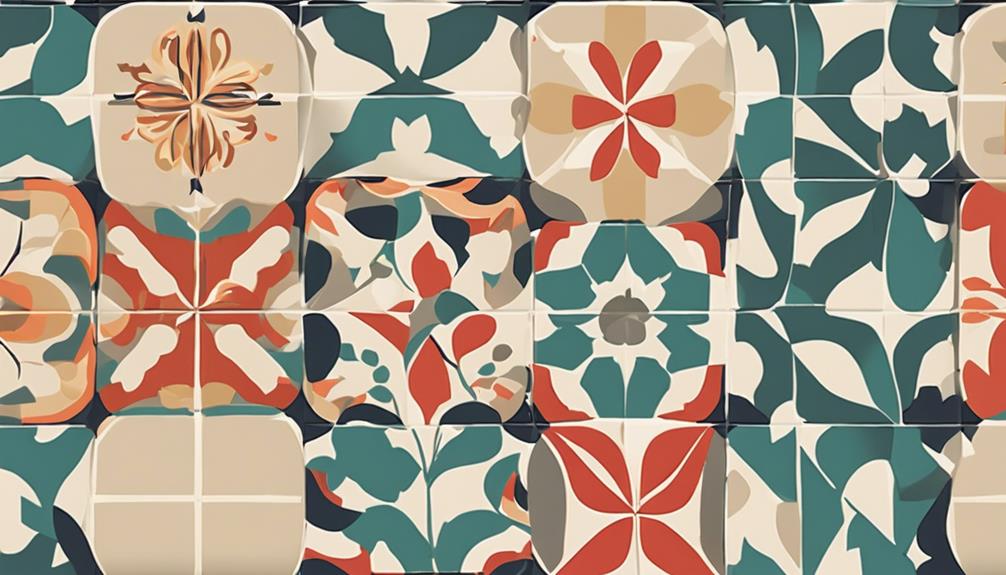
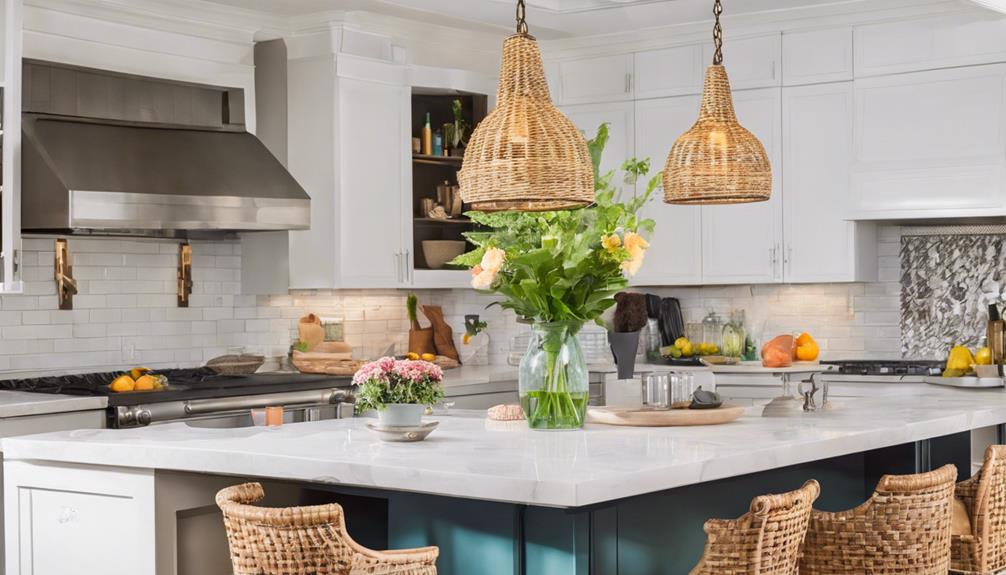
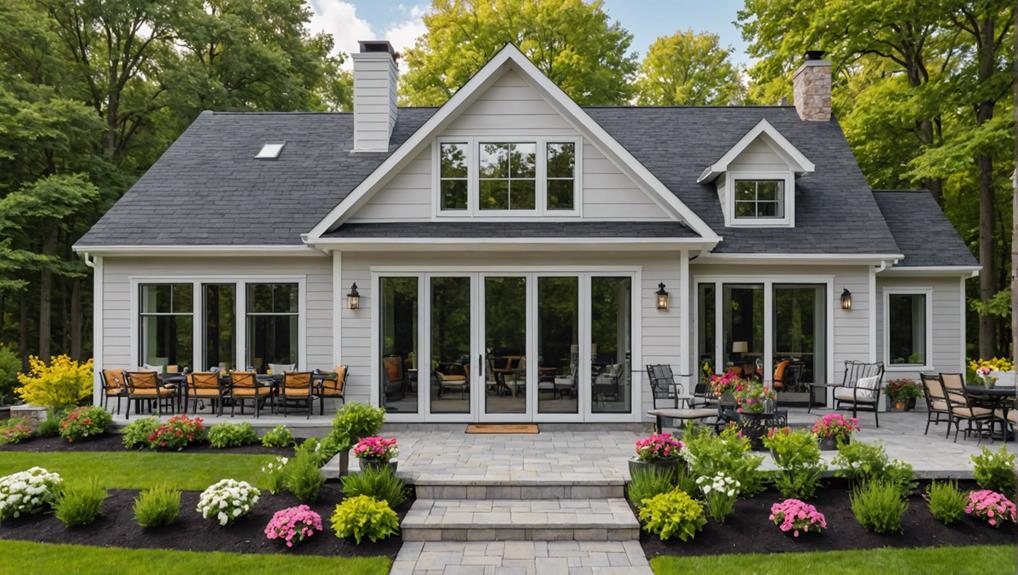
Leave a Reply